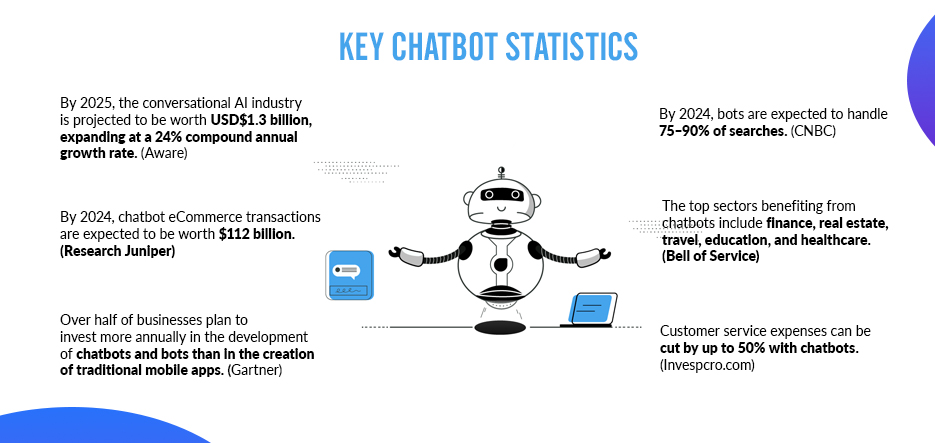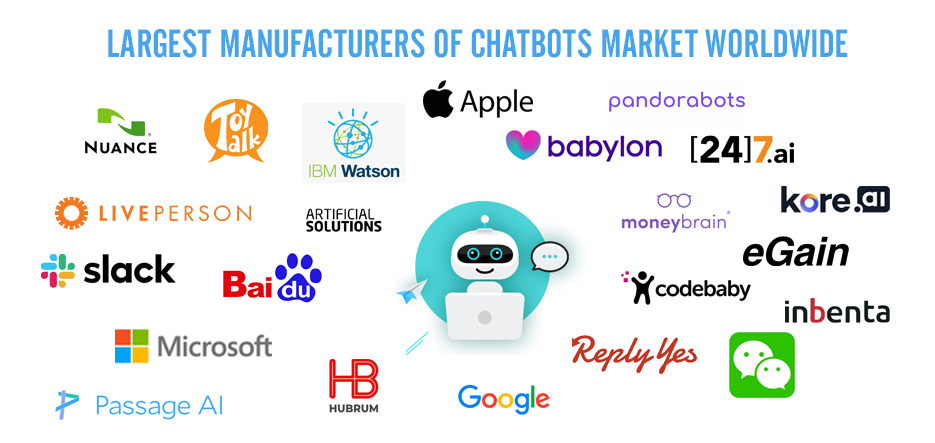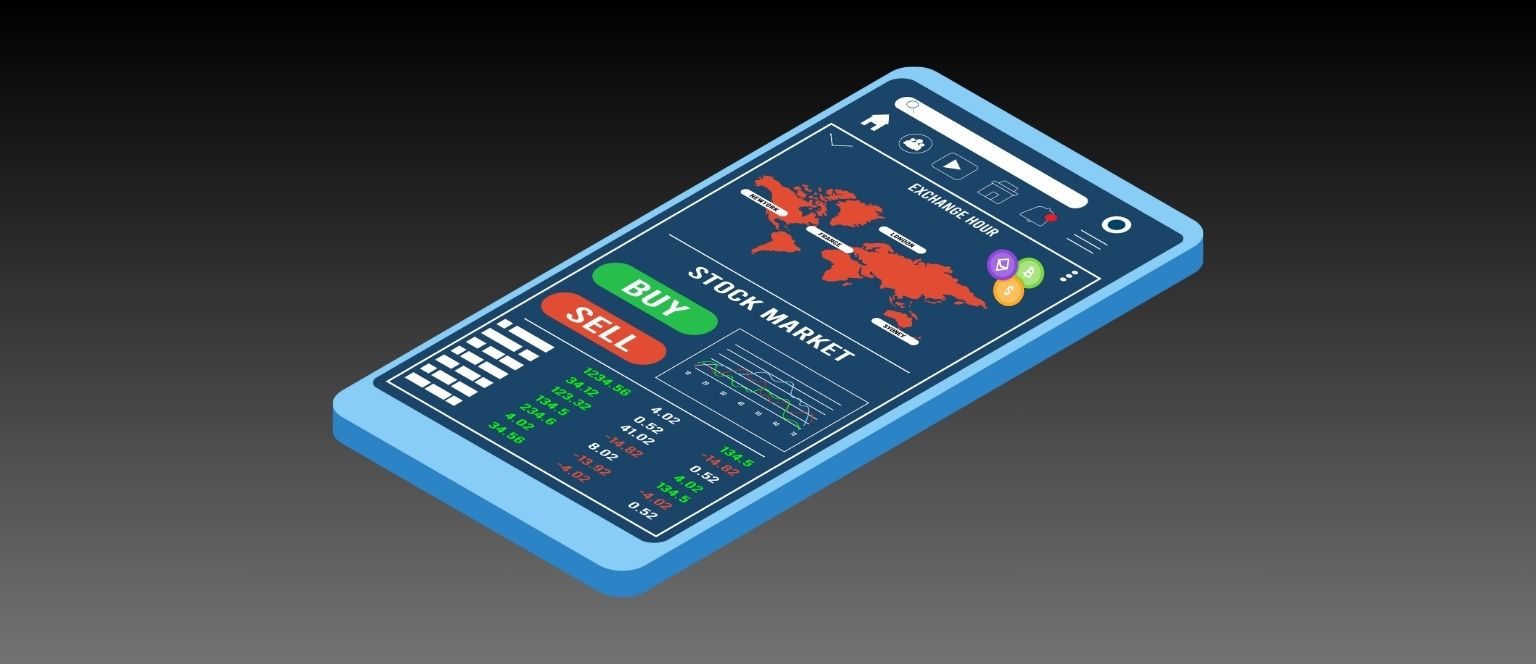Table of Contents
In the present digitized age, organizations are continually looking for ways of upgrading client experience and smoothing out their tasks. One such solution that has built up forward momentum is the execution of developing chatbots. These conversational AI services offer an easy-to-use interface for clients to communicate with organizations, giving instant help and customized help.
Chatbots have become increasingly popular due to their ability to automate repetitive tasks, improve reaction times, and provide 24/7 customer support. According to recent data, the global chatbot market is expected to reach $1.25 billion by 2025, growing at a CAGR of 24.3% during the forecast period.
Furthermore, the way to create effective and easy-to-use chatbots lies in understanding your interest group’s necessities and inclinations. By using Natural Language Processing (NLP) algorithms and AI methods, organizations can make chatbots that can understand and answer client questions more human like.
While developing chatbots, it means quite a bit to zero in on making a consistent and natural client experience. Moreover, combining features, for example, sentiment analysis and sentiment disclosure can additionally upgrade the chatbot’s capacity to understand and answer suitably to client feelings.
What is an AI chatbot?
An artificial intelligence chatbot is a PC software that utilizes natural language processing (NLP) and AI algorithms to create human-like conversations with clients. Overall, it is intended to understand and answer client questions or requests conversationally.
Not at all like customary decide-based chatbots that follow predefined scripts, AI chatbots influence NLP procedures to grasp the setting of client input and give applicable and exact reactions. Furthermore, they can learn and adjust over the long run, persistently working on their understanding and communication capacities.
Artificial intelligence built chatbots can be sent across different platforms, for example, sites, informing applications, and virtual entertainment platforms, permitting organizations to draw in clients any place they are generally dynamic.
With advancements in AI innovation, best AI chatbots are turning out to be more modern and equipped for grasping complex questions, perceiving client goals, and giving customized proposals. They can perform tasks like responding to as often as possible clarified pressing issues, directing clients through a site or application, operating businesses, and in any event, making suggestions given client inclinations.
In general, AI chatbots offer organizations a smart answer for further developing client care, incrementing ability, and driving client fulfillment. Moreover, as the chatbot market keeps on developing, organizations need to build easy-to-understand chatbots that can address their clients’ issues and assumptions.
By using the force of AI and NLP, organizations can develop chatbots that give consistent and customized cooperation, eventually upgrading the general client experience.
Building an easy-to-understand chatbot for business requires cautious thought of your main interest group’s necessities and inclinations. Overall, by utilizing Natural Language Processing (NLP) algorithms and AI procedures, you can make chatbots that offer a more human-like discussion experience.

Market Overview Of Chatbot
- The chatbot market is seeing huge development and is supposed to arrive at a worth of $1.25 billion by 2025, developing at a CAGR of 24.3% from 2019 to 2024.
- The rising reception of chatbots across different businesses like retail, medical care, banking, and e-commerce is driving the market development.
- Medical care is supposed to be the fastest-developing industry for chatbots, with a CAGR of more than 30% during the forecast period.
- The retail business is supposed to have the biggest share regarding income, because of the rising interest in customized client experiences and 24/7 client service.
- Chatbots are broadly utilized in client care applications, as they can give fast responses and handle various requests altogether, decreasing the requirement for human mediation and further developing productivity.
- Using AI advances in developing chatbots is upgrading their capacities, permitting them to grasp normal language, gain from communications, and give more customized responses.
- Chatbots are additionally being incorporated with social media platforms, for example, Facebook Messenger and WhatsApp, empowering organizations to arrive at clients through their favored communication channels.
- Furthermore, chatbots are being utilized for lead generation, deal approval, and advertising automation, further driving market development.
- The Asia-Pacific district is supposed to have the most noteworthy development rate in the chatbot market, because of the rising reception of cutting-edge innovations and the developing online business industry in nations like China and India.
- A portion of the central members in the chatbot market incorporate IBM Enterprise, Google AI chatbot LLC, Microsoft Company, Facebook Inc., and Amazon.com Inc. Overall, these organizations are putting resources into artificial intelligence development and AI innovations to create progressed chatbot answers for organizations.
Launch Your Bots With Top Chatbot Development Services
Chatbots: An Important Paradigm for Business
Chatbots have turned into a significant worldview for organizations today, as they offer various advantages and satisfy a critical need in the cutting-edge business scene. These insightful specialists offer robotized help and help to clients, working on their general insight and improving business activities. The following are ten vital advantages of integrating chatbots into your business:
1. 24/7 Availability:
In contrast to human specialists, chatbots are accessible nonstop, permitting organizations to offer instant help and help to clients whenever of the day.
2. Cost-effective:
Chatbots can deal with a huge volume of client requests at the same time, decreasing the requirement for HR and bringing down functional expenses.
3. Further developed Proficiency:
Via mechanizing repetitive tasks and giving speedy responses, chatbot developers can save organizations time and increment efficiency.
4. Personalized Interactions:
Through NLP procedures, chatbots can grasp client inclinations and give customized proposals, making a more custom-made and drawing-in client experience.
5. Faster Response Times:
Chatbots can give moment reactions to client requests, taking out the requirement for clients to hang tight for a human specialist and further developing general response times.
6. Versatility:
Chatbots can deal with different discussions all the while, making them deeply adaptable and equipped for supporting an enormous volume of client communications.
7. Decreased Errors:
Chatbots are less inclined to make mistakes compared with human specialists, guaranteeing predictable and precise responses to client requests.
8. Increased Customer Satisfaction:
By giving fast and customized help, developing chatbots can improve the general client experience and increment consumer loyalty levels.
9. Data Collection and Analysis:
Chatbots can gather important data about client inclinations, conduct, and needs, which can be utilized for additional analysis and business experiences.
10. Competitive Advantage:
Integrating chatbots into your business can give you a strategic advantage by offering inventive and proficient client care, drawing in additional clients, and further developing brand fame.
To build an easy-to-understand chatbot, focus on the accompanying key concerns is important:
1. Understand Your Audience:
Explored and examined your ideal interest group’s requirements, inclinations, and communication style. Furthermore, this will assist you with planning a chatbot that communicates in their language and measures up to their assumptions.
2. Define Clear Goals:
Decide the particular tasks and goals your chatbot ought to achieve. Overall, this will direct the discussion stream and guarantee that your chatbot gives relevant and significant help to clients.
3. Design a Conversational Flow:
Guide out the various ways or situations that clients could explore while collaborating with the chatbot. Furthermore, plan an absolute and natural discussion stream that guides clients through these ways, guaranteeing a consistent and easy-to-understand insight.
4. Use Natural Language Processing (NLP):
Execute NLP chatbot strategies to empower your chatbot to understand and solve client input precisely. Moreover, this will take into account more regular and significant discussions with clients.
5. Provide Clear Instructions:
Convey the abilities of your chatbot and give guidelines on the best way to utilize it. Furthermore, this will assist clients with understanding how to collaborate with the chatbot and increase their experience.
6. Offer Multiple Communication Channels:
Permit clients to communicate with your chatbot through different channels, like sites, informing platforms, or social media. Overall, this adaptability gives comfort to clients and increases openness.
7. Test and Repeat:
After developing a chatbot, constantly test your chatbot’s presentation and assemble criticism from clients. Utilize this information to make upgrades and highlight your chatbot’s plan and usefulness. Overall, customary testing will assist you with recognizing any issues or regions for development, guaranteeing that your chatbot remains easy to understand and effective.
8. Provide Human Support:
While chatbots can deal with numerous client requests, having a backup choice for mysterious or hypersensitive issues is significant. Offer clients the choice to promote their discussion to a human specialist when required.
9. Personalize the Experience:
Integrate personalization features into your chatbot to make communications more custom-made and applicable to every client. Furthermore, use client data and inclinations to give customized proposals or ideas, making a seriously compelling and customized insight for clients.
10. Continuous development:
Routinely dissect the presentation and viability of your chatbot through measurements, for example, response time, consumer loyalty evaluations, and transformation rates. Building an easy-to-use chatbot includes figuring out your crowd, characterizing clear objectives, and planning a conversational stream that guides clients through various ways.
Furthermore, reducing human help for complex issues, customizing the experience, and constantly working on the chatbot in light of measurements and criticism are fundamental platforms in making an easy-to-understand chatbot for your business. By following an enterprise AI chatbot development service, you can create a chatbot that gives significant help to clients.
Are You Ready to Revolutionize Your Chats? Connect With The Best Chatbot Development Company
Importance Of Chatbots for Business
According to Mordor Intelligence, the chatbot market will grow over 34% between 2021 and 2026, when the market is expected to reach $102 billion. Driven by advances in natural language understanding (NLU), chatbots have become a staple of digital transformation in customer service, healthcare, and financial services by providing intelligent interactions between people and a digital interface.
The new AI is the latest chatbot from the Elon Musk-founded independent research body OpenAI Foundation. The new chatbot keeps the good caliber to invest hard in businesses. Advancing them to another level.
Musk co-founded the startup with other Silicon Valley investors including technology venture capitalist Sam Altman in late 2015, saying that the research center would “advance digital intelligence in the way that is most likely to benefit humanity” according to a blog post at the time.
Real-world applications could include generating content for websites, answering customer inquiries, providing recommendations as well as creating automated chatbots.
Sam Altman, OpenAI CEO, said the system was “an early demo of what’s possible”. “Soon you will be able to have helpful assistants that talk to you, answer questions, and give advice. Later you can have something that goes off and does tasks for you. Eventually, you can have something that goes off and discover new knowledge for you.”

List Of Benefits That Make Chatbots Important For Business
1. Improved client care:
Chatbots give organizations the capacity to propose nonstop client service, guaranteeing that their clients’ questions are tended to immediately. Furthermore, this leads to expanded consumer loyalty and devotion.
2. Cost-effective solution:
Carrying out chatbots can decrease functional expenses for organizations as they wipe out the requirement for HR to deal with routine client requests. Furthermore, this permits AI chatbot development company to distribute their spending plan towards other significant business regions or put resources into additional work on their items and services.
3. Expanded proficiency:
Chatbots can deal with various client collaborations all the while, lessening stand-by times and further developing reaction times. Overall, this works on general effectiveness and permits organizations to deal with more requests without settling for less quality.
4. Personalized experiences:
With the utilization of AI by top artificial intelligence companies and ML algorithms, chatbots can analyze client information and give customized proposals given individual inclinations and past collaborations. Furthermore, this makes a more customized and custom-made insight for clients, expanding their commitment to the business.
5. Lead generation and conversion:
Chatbots can be incorporated with lead age tools and CRM frameworks to catch important client data and produce leads. By drawing in clients in significant discussions, chatbots can collect data that can be utilized for fixed advertising efforts and eventually increment change rates.
Developing chatbots in organizations offers a scope of advantages that can upgrade client care, further develop productivity, and drive lead age. Furthermore, one key benefit is the capacity of chatbots to give nonstop client care, guaranteeing that clients’ questions are speedily tended to.
Besides, executing chatbots is a practical answer for organizations as it takes out the requirement for HR to deal with routine client requests. Overall, this lessens functional expenses and permits organizations to distribute their financial plan toward other significant regions.
Furthermore, chatbots use artificial intelligence and AI algorithms to dissect client information and give customized suggestions in light of individual inclinations and past associations.
Step By Step Process Of Chatbot Development
Building an easy-to-use chatbot for your business can be an intricate task, however, by following a step-by-step process, you can guarantee that your chatbot is proficient, effective, and addresses the issues of your clients. Here are the key advances associated with chatbot development and the conversational AI development company:
Define the purpose and scope:
– Obviously recognize the motivation behind your chatbot – whether it’s client assistance or lead age – and decide the particular terms and capabilities it will perform.
– Characterize the extent of your chatbot by stating its abilities, impediments, and ideal interest group. Furthermore, this will assist you with setting reasonable assumptions and guarantee that your chatbot is intended to address the issues of your clients.
Choose a platform or framework:
– Select a platform or system for building your chatbot. There are a few choices accessible, like Facebook Messenger, Slack, or exceptionally simulated structures like Dialogflow or Microsoft Bot System. Furthermore, consider factors like usability, binding abilities, and the objective platform for launching.
Design the conversation flow:
– Make a conversational flowchart that frames the various ways and collaborations clients can have with your chatbot. Overall, this will assist you with outlining the client experience and guarantee a smooth and sensible discussion stream.
– Consider various situations and client contributions to expect potential reactions and give suitable responses or ideas.
4. Develop the chatbot:
– Utilize the AI chatbot development platform or structure to create your chatbot. This includes composing code or utilizing visual devices given by the platform to make the essential conversational rationale, and reaction generation, and mix with outer frameworks whenever required.
– Test your chatbot completely to guarantee it works accurately and gives precise responses. Furthermore, this might include leading client testing, investigating issues, and purifying the chatbot’s usefulness.
5. Deploy and monitor:
– Once your chatbot is created and tried, send it on your picked platform or coordinate it into your site or application. Monitor its presentation and gather criticism from clients to recognize any areas of progress or feature likely issues.
– Routinely examine the data gathered from client associations to distinguish examples, trends, and regions where the chatbot can be additionally advanced. This might include refining the discussion stream, adding new features or abilities, or refreshing the chatbot’s responses given criticism.
– Constantly monitor the chatbot’s display and make essential updates or upgrades to guarantee it remains easy to understand and successful in the necessary group.
Enhance the user experience:
To guarantee a consistent and easy-to-understand chatbot experience, center around upgrading the UI and collaboration plan. Furthermore, think about the visual components, like tones, text styles, and symbols, to make an engaging and instinctive connection point. Integrate clear directions and leads to direct clients through the discussion stream.
Personalize the conversations:
Modify your chatbot’s response given client preferences, history, and settings. Furthermore, this should be possible by incorporating client data and using AI experts’ algorithms to give customized proposals, ideas, or solutions.
Implement natural language processing:
Consolidate normal language handling (NLP) methods to empower your chatbot to understand and answer client inputs in a more human-like way. Furthermore, this can include utilizing pre-fabricated NLP models or preparing your models to work on the chatbot’s understanding and response generation capacities.
Provide fallback options:
In situations where the chatbot can’t understand or answer a client’s feedback, give backup choices, for example, recommending elective questions, guiding the client to a human specialist, or offering important self-development assets.
Integrate with external systems:
Depending on your business needs, incorporate your chatbot with outside frameworks like customer relationship management (CRM) software, stock services frameworks, or payment gateways. This reconciliation permits the chatbot to get to important data and perform activities directly inside the discussion.
Test completely:
Before launching your chatbot, direct testing to guarantee its usefulness and execution. Test different situations, data sources, and edge cases to distinguish any bugs or issues that should be tended to.
Gather user feedback:
Gather feedback from clients after they communicate with your chatbot. This should be possible through studies, meetings, or checking client surveys and criticism via social media entertainment platforms. Utilize this input to recognize regions for development and make essential updates to improve the client experience and address any issues or concerns.
13. Continuously iterate and improve:
Chatbot development is a continuous cycle. Consistently analyze client criticism, monitor execution measures, and distinguish open doors for development. Execute refreshes, new features, or development in light of client needs and changing business prerequisites.
Drive Conversions With Chatbot Development For Your Business
Technologies For Chatbot Development
With regards to creating easy-to-understand chatbots for your business, it is fundamental to pick the right innovations that can support their usefulness. The following are six key developments ordinarily utilized in chatbot development:
Natural Language Processing (NLP):
NLP is an innovation that empowers chatbots to understand and translate human language. It helps the chatbot grasp client questions, distinguish their purpose, and create appropriate responses.
Machine Learning (ML):
ML solutions are utilized in developing chatbots and working on their show over the long run. Overwhelmingly, ML models can learn examples and make expectations or suggestions given client conduct.
3. Application Programming Interfaces (APIs):
APIs permit chatbots to incorporate outside frameworks and services, empowering them to get to and recover data or perform activities. For instance, combining CRM APIs can give the chatbot client data, permitting it to customize responses given client history or preferences.
4. Natural Language Generation (NLG):
NLG innovation empowers chatbots to create human-like responses by changing over-organized information into regular language. It helps in making customized and logically important responses for clients. NLG can be utilized to powerfully create item descriptions, FAQs, or other text-based content.
5. Speech Recognition:
This innovation empowers chatbots to understand and deal with communication in language. It changes speech into text, permitting the chatbot to break down and answer voice inputs. Speech recognition is especially valuable in situations where clients like to cooperate with the chatbot through voice orders as opposed to writing.
6. Sentiment Analysis:
Sentiment analysis innovation helps chatbots understand and examine the feelings and decisions communicated by clients in their connections. It can distinguish positive, negative, or unbiased opinions in client data sources and developer responses appropriately.
Use Cases Of Chatbots In Business
Chatbots have turned into a fundamental piece of numerous organizations, reforming how organizations collaborate with their clients. They offer a scope of use cases that can help organizations across different businesses. The following are six use cases of chatbots in business:
1) Customer assistance:
One of the most popular uses of chatbots is in client care. Chatbots can deal with a high volume of client requests, giving quick and exact responses to real-time inquiries.
2) Lead Generation:
Chatbots can be utilized to draw in site guests and catch leads. By starting discussions with clients, chatbots can gather contact data and qualify leads given foreordained measures.
3) E-commerce Assistance:
Chatbots can improve the Internet business experience by assisting clients with tracking down items, helping with buying choices, and giving customized suggestions.
4) Appointment Scheduling:
Chatbots can be coordinated with booking frameworks to help clients in booking a spot. They can give constant accessibility, propose appropriate schedule slots, and handle the whole reserving process. This not only saves time for the two clients and organizations but also decreases the risk of human error in planning.
5) Content Delivery:
Chatbots can convey customized content to clients in light of their inclinations and interests. They can suggest articles, blog entries, recordings, or other applicable meanings to keep clients connected.
6) Virtual Assistants:
Chatbots can work as virtual assistants to assist clients with tasks like setting updates, managing schedules, sending messages, directing analysis, and giving general data insights. They can perform these tasks rapidly and proficiently, saving clients time and exertion.
These are only a few instances of how chatbots can be used in a business environment. The potential outcomes are huge.
Popular AI Platforms For Chatbot Development
1) Dialogflow (previously known as API.AI):
Dialogflow, created by Google, is a well-known AI platform for developing chatbots.
- It offers a thorough solution of tools and features for building conversational specialists.
- Dialogflow uses natural language processing and AI algorithms to understand client inputs.
- It upholds different languages, Speech recognition, and text-to-speech capacities.
- Dialogflow gives joining different channels like Facebook Messenger and Slack, empowering organizations to arrive at clients any place they are.
2) Watson Assistant:
- Watson Assistant is an AI platform for developing chatbots, utilizing IBM Watson’s natural language processing capacities.
- Organizations can without much of a stretch plan, train, and launch chatbots across different channels utilizing Watson Assistant.
- It offers a user-friendly interface with simplified usefulness for building conversational streams and overseeing intents and entities.
- Watson Assistant gives advanced features like sentiment analysis, commodity extraction, and contextual knowledge for more meaningful interactions.
- It upholds a combination of different applications and frameworks, upgrading chatbot capacities.
3) Microsoft Bot Framework:
- Microsoft Bot System is a platform for building smart chatbots.
- You can hire AI developers that provide tools, SDKs, and services for making bot applications.
- The structure upholds numerous programming languages like C#, JavaScript, and Python.
- It incorporates features like NLP through Microsoft’s LUIS.
- Microsoft Bot Structure offers an adaptable solution with reconciliation choices and strong documentation.
4) Amazon Lex:
- Amazon Lex is an artificial intelligence platform created by Amazon Web services explicitly for developing chatbots.
- It involves a similar innovation to Amazon Alexa to make conversational connection points with voice and text capacities.
- Amazon Lex has normal language understanding abilities utilizing deep-gaining algorithms to extricate pertinent data from client inputs.
- The platform gives an easy-to-understand connection point for planning conversational streams and overseeing purposes and starts.
- Amazon Lex offers work in coordination with other AWS platform services, permitting organizations to improve chatbot capacities and incorporate them with existing frameworks.
To Conclude
Taking everything into account, creating easy-to-use chatbots for your business can essentially upgrade client experience and work on general proficiency. By following the step-by-step guide illustrated in this article, you can guarantee that your chatbot is intended to address the issues of your clients.
Make sure to begin by characterizing clear objectives and targets for your chatbot, for example, giving moment client service or working with consistent exchanges. Lead intensive exploration of your interest group and their inclinations to understand how your chatbot can best serve them.
Then, pick the right conversational AI platform and innovation for building your chatbot. Consider factors like versatility, coordination abilities, and usability. It’s likewise critical to focus on the client experience by planning a straightforward and instinctive connection point that permits clients to explore the discussion without any problem.
Furthermore, utilize Natural Language Processing (NLP) services to empower your chatbot to understand and answer client messages in a more human-like way. This can enormously further develop the client experience by giving more precise and important responses.
FAQ
1. What is a chatbot and why is it important for my business?
A chatbot is a product application that utilizes AI to communicate with clients through text or voice-based conversations. It is significant for organizations as it can automate client communications, further develop client support, and upgrade client experience.
2. What key features should be considered while developing a user-friendly chatbot?
A few important features to consider while building an easy-to-use chatbot incorporate NLP capacities, customized responses, consistent reconciliation with different frameworks and platforms, visionary critical thinking skills, and the capacity to deal with various languages.
3. How can I ensure that my chatbot is user-friendly?
To guarantee that your chatbot is easy to understand, it is essential to direct specific client testing and accumulate input from clients during the advancement interaction in the development cycle. This will assist with determining any comfort issues and make critical enhancements. It is likewise important to plan an informal connection point that is simple to explore, give clear directions and leads, and present supportive ideas or choices to clients.
4. How can I make my chatbot more engaging for users?
To make your chatbot more captivating make fundamental upgrades. It is likewise important to plan a conversational connection point that is instinctive and simple to explore, give clear guidelines and leads, and propose supportive thoughts or choices to clients.
5. Can I customize my chatbot’s responses to align with my brand’s tone and style?
Indeed, you can modify your chatbot’s responses to line up with your image’s tone and style. This should be possible by making a predefined set of reactions that mirror your image’s character and voice. You can likewise reduce direct taglines or phrases that are one of a kind to your image into the chatbot’s language model to guarantee constant communication.






